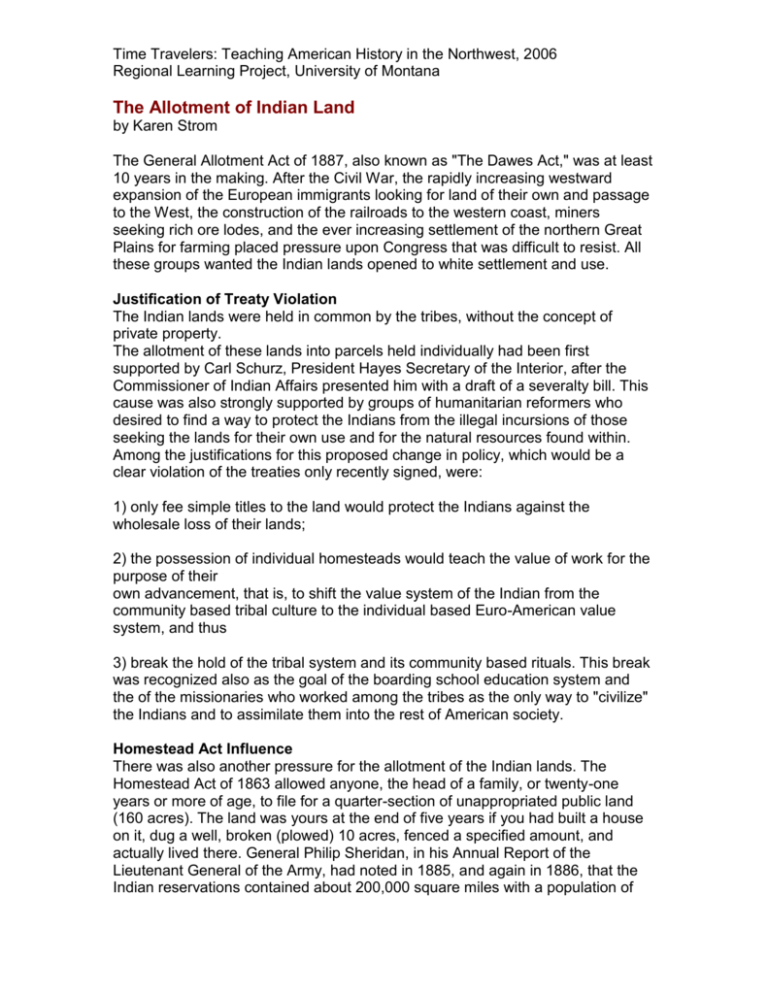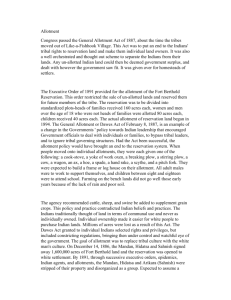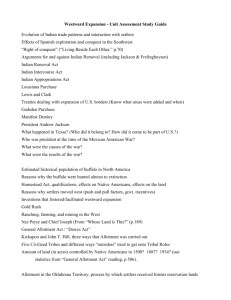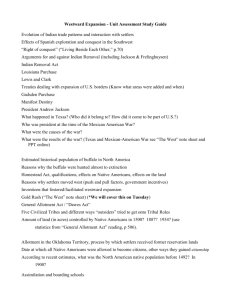The Allotment of Indian Land - Teaching American History in the
advertisement

Time Travelers: Teaching American History in the Northwest, 2006 Regional Learning Project, University of Montana The Allotment of Indian Land by Karen Strom The General Allotment Act of 1887, also known as "The Dawes Act," was at least 10 years in the making. After the Civil War, the rapidly increasing westward expansion of the European immigrants looking for land of their own and passage to the West, the construction of the railroads to the western coast, miners seeking rich ore lodes, and the ever increasing settlement of the northern Great Plains for farming placed pressure upon Congress that was difficult to resist. All these groups wanted the Indian lands opened to white settlement and use. Justification of Treaty Violation The Indian lands were held in common by the tribes, without the concept of private property. The allotment of these lands into parcels held individually had been first supported by Carl Schurz, President Hayes Secretary of the Interior, after the Commissioner of Indian Affairs presented him with a draft of a severalty bill. This cause was also strongly supported by groups of humanitarian reformers who desired to find a way to protect the Indians from the illegal incursions of those seeking the lands for their own use and for the natural resources found within. Among the justifications for this proposed change in policy, which would be a clear violation of the treaties only recently signed, were: 1) only fee simple titles to the land would protect the Indians against the wholesale loss of their lands; 2) the possession of individual homesteads would teach the value of work for the purpose of their own advancement, that is, to shift the value system of the Indian from the community based tribal culture to the individual based Euro-American value system, and thus 3) break the hold of the tribal system and its community based rituals. This break was recognized also as the goal of the boarding school education system and the of the missionaries who worked among the tribes as the only way to "civilize" the Indians and to assimilate them into the rest of American society. Homestead Act Influence There was also another pressure for the allotment of the Indian lands. The Homestead Act of 1863 allowed anyone, the head of a family, or twenty-one years or more of age, to file for a quarter-section of unappropriated public land (160 acres). The land was yours at the end of five years if you had built a house on it, dug a well, broken (plowed) 10 acres, fenced a specified amount, and actually lived there. General Philip Sheridan, in his Annual Report of the Lieutenant General of the Army, had noted in 1885, and again in 1886, that the Indian reservations contained about 200,000 square miles with a population of Time Travelers: Teaching American History in the Northwest, 2006 Regional Learning Project, University of Montana only 260,000 Indians. Allotting the reservations in the same manner as the Homestead Act prescribed would leave 170,000 square miles of "excess" lands that could be sold off, and the proceeds could be used to support the Indians. There was vocal opposition to the allotment of Indian lands. Considerable debate within the reformers community over the effect of allotment on the Indian communities and cultures took place. When the Indian agents were asked for their opinion, they almost universally opposed allotment. Many government officials, including George W. Manypenny, a former Commissioner of Indian Affairs, who had supervised small scale allotment programs previously, spoke out against allotment of Indian lands to individuals. In response to these pressures, Sen. Richard Coke of Texas took over the sponsorship of the Allotment bill in 1880. The debate that took place in this year was the most extensive that ever took place on this issue. An attempt to protect the Indians by holding the "excess lands" in trust and inalienable for a period of 25 years. The individual allotments were also to be protected in this way. Strong arguments were made against the bill by several who pointed out that this policy would be disastrous for the Indians, divesting them of most of their land in a very few years. A provision had been written into the bill that allotment of the reservation must be approved by 75% of each tribe before it could take place. However this protection was soon removed, allowing allotment to be imposed without the agreement of the tribal members. Indian Citizenship During the period when this bill was under consideration, voting privileges were denied to an Indian man, John Elk, living off the reservation in Nebraska and working his own land on the grounds that he was not a citizen. This decision was upheld by the Supreme Count with two justices dissenting. To correct this obvious miscarriage of justice, a clause was added to the Allotment bill (Section 6) granting citizenship to Indians "to whom allotments shall have been made under the provisions of this act, or under any law or treaty, and every Indian born within the territorial limits of the United States who has voluntarily taken up, within said limits, his residence separate and apart from any tribe of Indians therein, and has adopted the habits of civilized life, . . . " "Excess Lands" and Railroads Over the next few years, after more concessions were made to the political pressures, it became clear that the bill would never pass as long as the "excess lands" remained inalienable for 25 years after allotment. Therefore this final concession was made allowing the bill to pass "in record time" in 1887. While the railroads had not taken an active part in pushing for the allotment act, allowing others to carry the battle, they were clearly the most immediate beneficiary. In the same session of Congress in which the Dawes Allotment Act was passed, six of the nine Indian bills that were passed were grants to railroads. Time Travelers: Teaching American History in the Northwest, 2006 Regional Learning Project, University of Montana In the following session, the first session of the Fiftieth Congress, 13 laws granting railroads rights-of-way through Indian lands, while in the second session 10 more such bills were passed. These land grants began the "checkerboarding" of the reservations that still create enormous problems of jurisdiction in law enforcement today. Farming vs. Leasing The supporters of the Allotment Act had apparently failed to consider that not every Indian would choose to farm. Those who wished to homestead had freely made the choice themselves. The Indians were given no choice. All were expected to farm, independent of age, disability or desire. No provision had been made to allow any Indians to lease their allotment in order to gain income from it while following another path. In February of 1981, the Dawes Act was amended to allow such leasing of allotments. Eventually, individual allotments could be sold, and many were, to pay taxes or other bills requiring cash payment. In this way, with the right-of-way grants, sales of the "surplus lands" and of individual allotments, much of the original reservation land was lost. From 138 million acres in 1887, reservation land holdings had shrunk to 48 million acres by 1934. Consequences of Allotment One of the intended consequences of allotment was to break up tribal communities by moving individuals and families away from the communities and onto isolated homesteads. Indian agents could then stop dealing with tribal leaders and deal only with individuals. This tactic has been only partially successful. There is now a large urban Indian community, generated in part by the loss of family allotments, but tribal communities remain on the reservations and many in the urban Indian communities maintain ties with the reservation. New Deal With the New Deal came a different attitude toward relations with the Indian tribes. The change in attitude began in the Hoover administration and reached its culmination with the appointment of John Collier as Commissioner of Indian Affairs in 1933 in the Roosevelt administration. Many New Deal agencies greatly benefited the Indians by giving immediate relief from the grinding poverty of the Depression by offering employment. In 1933, Collier began implementing his goal of reversing the allotment process by ordering a stop to the sale of trust lands and other provisions of the Dawes Act. In 1934, with Collier's strong pushing, and President Roosevelt's support, the Wheeler-Howard Act, otherwise known as the Indian Reorganization Act, was passed. This bill repealed allotment by prohibiting further allotment, extending trust periods and restriction on alienation of Indian land. "Surplus" lands were returned to the tribes. Individual allotments could be voluntarily returned to tribal ownership. Additional lands could be acquired for the tribes. Indian tribes could now organize for their common welfare, adopting a constitution and bylaws, which must be ratified by a majority of the adult Time Travelers: Teaching American History in the Northwest, 2006 Regional Learning Project, University of Montana members of the tribe, or opt to exclude themselves from this process. A tribe so organized could hire legal counsel, negotiate with local, state and federal governments, prevent the sale of tribal assets, and manage its own property. The act also set up a revolving loan fund to help tribes with economic development, provided for loans to Indian students in vocational and trade schools, and gave preferential hiring treatment within the Indian service to Indian applicants. References The Assault on Indian Tribalism. Wilcomb E. Washburn, Robert E. Kreiger Publishing Co., 1986 Buffalo Bird Woman's Garden. Gilbert T. Wilson, Minnesota Historical Society Press, 1987. The Encyclopedia of North American Indians. Frederick Hoxie (Editor), Houghton Mifflin Co., 1996. The Great Father: The United States and the American Indian. Francis Paul Prucha, Univ. Nebraska Press. 1986






